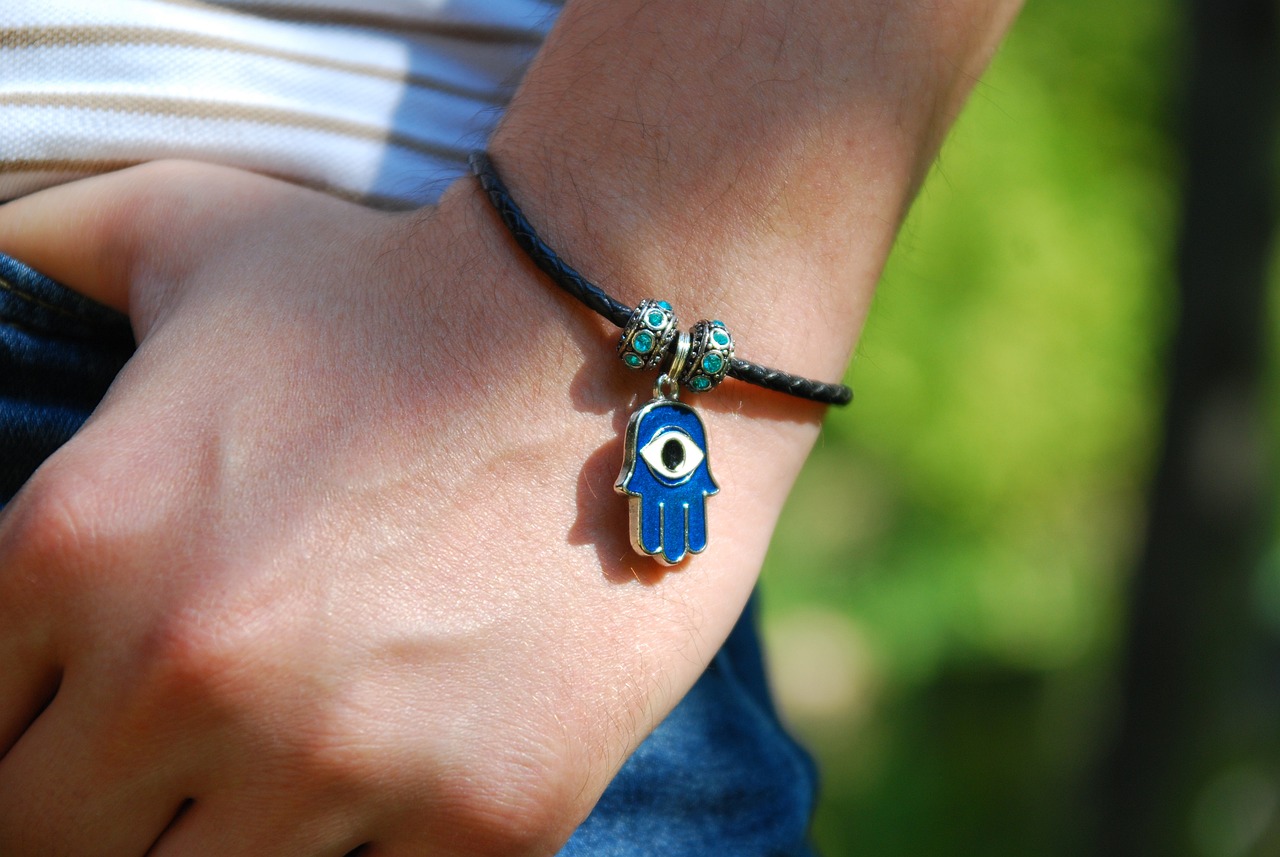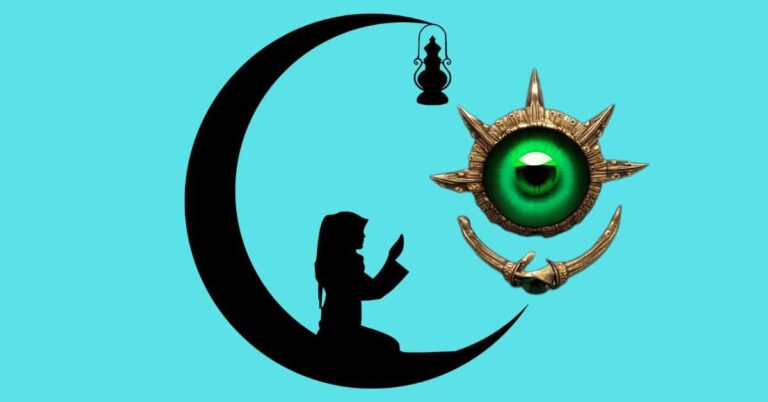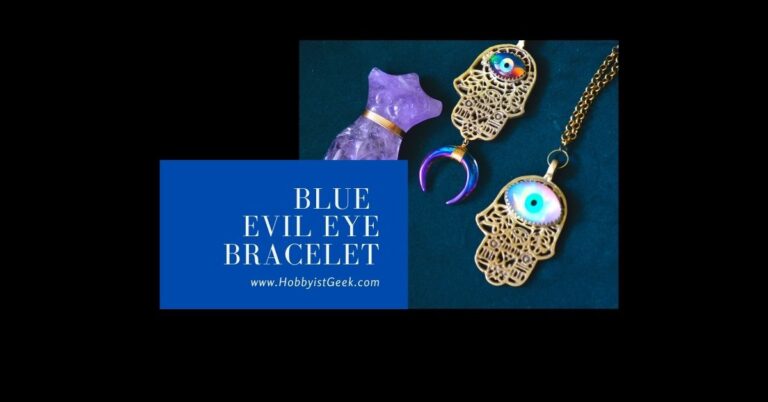Evil Eye Hand: Unveiling the Mystical Origins and Meanings

Introduction
Evil Eye Hand… The evil eye hand, also known as the hamsa hand, is a captivating symbol that has intrigued people across different cultures for centuries. Its roots can be traced back to ancient times when various civilizations believed in the power of amulets and charms to protect against the malevolent gaze of the evil eye.
This mystical symbol holds deep cultural significance and has been passed down through generations, evolving and adapting to different regions of the world. The history and origins of the evil eye-hand symbol are as intriguing as its intricate design.
Its presence can be found in ancient Middle Eastern and North African cultures, where it was considered a potent protective talisman against ill intentions. The belief in warding off the evil eye has since spread to other regions, such as Europe and South Asia, albeit with their own unique interpretations.
Symbolically, the evil eye hand represents much more than just a safeguard against negative energies. It carries multifaceted meanings that are deeply ingrained in various societies.
For some, it serves as a reminder of divine protection or spiritual guidance. Others perceive it as a symbol of strength and resilience in adversity.
Moreover, the cultural significance attached to this enigmatic symbol extends beyond its spiritual connotations. The evil eye hand has emerged as an artistic motif seen in paintings, ceramics, jewelry designs, and even tattoos throughout history.
It is fascinating how this ancient emblem has seamlessly transitioned into contemporary culture while retaining its core symbolism. However, like any culturally significant symbol, issues surrounding cultural appropriation have arisen concerning the hamsa hand‘s usage outside its original context.
The delicate balance between appreciation for diverse cultural beliefs and commodifying sacred symbols deserves thoughtful consideration. Exploring the origins and meanings behind the evil eye hand unravels a fascinating tapestry woven with history and symbolism.
From its humble beginnings as an amulet believed to protect against malevolent glances to its present-day presence in various forms of artistry, this iconic symbol continues to inspire and captivate. In the following sections, we will delve deeper into the cultural significance of the evil eye-hand, its psychological and sociological implications, and the ways it has manifested in different regions of the world.
The meaning and symbolism of the evil eye hand
The evil eye-hand, or the hamsa hand as it is also known, holds a rich tapestry of meaning and symbolism across various cultures. This captivating symbol has long been revered as a protective talisman against the malevolent gaze of the evil eye.
Its origins can be traced back to ancient civilizations in the Middle East and North Africa, where belief in the power of this symbol was deeply ingrained. The hamsa hand is widely recognized for its distinct shape, featuring an open hand with an eye at its center.
Its symbolic significance lies in its ability to ward off negative energies and bring good fortune to those who possess it. The evil eye hand’s symbolism spans across different regions of the world, each imbuing it with unique cultural significance.
For instance, in Jewish culture, it is often associated with the Hand of Miriam or the Hand of Fatima, both representing protection and blessings for individuals. In Islamic traditions, this powerful symbol is known as Khamsa and holds similar connotations of protection against harm and misfortune.
The Hamsa hand can also be found in Christian art where it is referred to as The Hand of Mary or The Hand of Mother Mary. This symbol resonates deeply within societies that hold a strong belief in the power of the evil eye.
Across cultures, people have been known to wear amulets adorned with the hamsa hand or display it within their homes as a means to protect themselves from ill intentions and ward off any negative influences that may come their way. Whether worn as jewelry or placed strategically around living spaces, these charms are seen as tangible symbols of security.
Moreover, beyond its instrumental role in warding off the evil eye’s malevolence, the hamsa hand carries profound spiritual implications for many individuals. It acts as a reminder to stay connected with one’s inner self while seeking spiritual balance and protection from external forces that may disrupt one’s harmony.
In contemporary culture, the hamsa hand has transcended its historical and cultural roots to become a popular symbol in various forms of art, fashion, and design. Its captivating aesthetics have captivated many across different regions of the world.
From fashion accessories like necklaces and bracelets to home decor items like wall hangings or decorative pieces, the hamsa hand has found a place in the hearts of people globally. However, as with any culturally significant symbol, issues surrounding cultural appropriation have emerged.
The hamsa hand‘s adoption by Western culture has sparked debates about respecting its origins and maintaining its sacred meaning within different cultural contexts. It is essential to approach the hamsa hand with an understanding of its deep-rooted symbolism and respect for the cultures from which it originated.
The evil eye hand, or hamsa hand, holds immense meaning and symbolism across cultures that believe in warding off malevolence through protective talismans. This ancient symbol carries both historical significance and spiritual connotations that resonate with individuals seeking protection from negative energies.
Its distinct shape and central eye make it instantly recognizable as a powerful charm against ill intentions. While modern society has embraced this symbol within contemporary culture, it is crucial to honor its origins and maintain respect for its cultural significance to ensure its continued relevance in our diverse world.
What Makes the Hamsa Hand Unique?
The history and origins of the evil eye hand symbol
The history and origins of the evil eye hand symbol are deeply rooted in ancient cultures across the Middle East and North Africa. This fascinating symbol has been passed down through generations, gaining significance in various religious traditions such as Judaism, Islam, and Christianity. In these early civilizations, the evil eye hand was believed to possess powerful protective qualities against the malevolent gaze of the evil eye.
It was a symbol that held great spiritual meaning, often depicted as an open hand with an eye in its center. In ancient Mesopotamia, the belief in the power of the evil eye hand can be traced back as early as 3000 BCE.
According to historical records, people would adorn their homes with amulets and charms incorporating this symbol to ward off misfortune. The Hamsa hand, as it is also known, became a widely recognized emblem across different regions of the world due to its potent symbolism.
Jewish culture has embraced this powerful talisman by incorporating it into their religious customs and practices. In Hebrew tradition, it is called “Hamsa,” derived from the Arabic word for five which represents God’s protective hand over his followers.
This embodiment of divine protection can be found on mezuzahs (protective scrolls placed on doorposts), hanging ornaments, or jewelry pieces worn by both men and women. Islamic culture also attributes immense significance to this ancient symbol.
Known as “Hand of Fatima” or “Khamsa,” it commemorates Fatima Zahra – daughter of Prophet Muhammad – who is highly revered within Islam. The Hand of Fatima serves as a reminder of her virtues and acts as a protective amulet against negative energies or ill-wishing.
Similarly, in Christian art and symbolism throughout history, depictions of hands imbued with an all-seeing eye have appeared alongside other sacred imagery signifying protection from evil forces. The widespread adoption and cultural significance surrounding this emblem have made it a powerful icon that transcends time and geographical boundaries.
It is worth noting, however, that in contemporary culture, the evil eye hand has become subject to cultural appropriation. As it gained popularity in Western societies, its sacred origins and spiritual meanings have sometimes been diluted or exploited for fashion or commercial purposes.
Understanding the history and origins of the evil eye hand symbol provides us with a deeper appreciation for its cultural significance as a protective talisman. Its intricate journey through time and its incorporation into various religious traditions enrich our understanding of this captivating symbol, which continues to captivate hearts across different regions of the world.
Hamsa Hand Check it out!
The cultural significance of the evil eye hand
The evil eye hand, with its mesmerizing design and intricate details, has carved a special place for itself in various cultures around the world. Its cultural significance extends far beyond its reputation as a protective talisman against the evil eye.
In fact, the evil eye hand’s symbolism has permeated different forms of art, literature, and popular culture. In recent years, the evil eye hand has become an iconic motif in fashion and jewelry design.
From delicate necklaces to statement rings, this ancient symbol has found its way onto runways and into the hearts of fashion enthusiasts worldwide. Its allure lies in its ability to blend seamlessly with contemporary styles while retaining a touch of mysticism from centuries past.
Artists and designers have embraced the cultural significance of the evil eye hand by incorporating it into their creations. Paintings featuring vibrant hamsa hands adorned with intricate patterns have graced gallery walls, capturing viewers’ attention with their rich symbolism and captivating aesthetics.
The prevalence of this symbol is not limited to one particular region; it spans across different cultures and geographies – testament to its global appeal. Moreover, literature has also drawn inspiration from the cultural significance of the evil eye hand.
Stories have been woven around its mystical powers, exploring themes such as protection against malevolent forces or journeys undertaken to find amulets bearing the hamsa hand symbol that grant special abilities or blessings. These narratives tap into our fascination with ancient traditions while igniting our imagination.
Beyond art and literature, popular culture has co-opted the meaning behind the evil eye hand as well. In movies and TV shows, characters often wear jewelry or display artwork featuring this powerful talisman – emphasizing its role in warding off negative energies or curses.
Celebrities have also embraced this trend by donning hamsa hand accessories on red carpets or incorporating them into their personal brand aesthetics. However, it is essential to recognize that while embracing symbols like the evil eye hand in contemporary culture can be seen as a celebration of diversity and cultural exchange, there is also a risk of cultural appropriation.
It is crucial to approach the use of these symbols with respect and understanding, acknowledging their history and origins. This way, we can ensure that their cultural significance remains intact while appreciating their beauty and symbolism in our modern world.
The psychological and sociological implications of the belief in the evil eye hand
The belief in the evil eye hand, as a protective talisman, can have profound psychological and sociological implications for individuals and societies alike. Psychologically, the fear of being on the receiving end of the evil eye can create a sense of vulnerability and anxiety. This belief taps into our innate need for safety and protection, as it is deeply rooted in our collective unconscious across different regions of the world.
Sociologically, the belief in the evil eye hand shapes social relationships and behavior. In cultures where this belief is prevalent, people often take precautions to ward off the evil eye.
They may wear amulets or charms featuring the symbol to protect themselves from malevolent glances. This shared belief fosters a sense of community and unity among individuals who share similar cultural backgrounds.
Furthermore, the fear of being affected by envy or ill intentions leads some individuals to be cautious about their achievements or possessions. They may avoid flaunting their success or displaying material wealth openly to appease any potential negative energy directed towards them.
These societal dynamics influenced by belief in the evil eye hand highlight its impact on both individual well-being and community dynamics. It’s important to note that while these psychological and sociological implications vary across different cultures and regions, they all stem from a shared belief in the power of this symbol.
Understanding these latent semantic indexing connections between cultural beliefs surrounding the evil eye hand can shed light on how it influences our thoughts, actions, and interactions with others. In contemporary culture, where cultural appropriation is an ongoing concern, it becomes crucial to approach symbols like the evil eye hand respectfully.
The commercialization and commodification of such symbols without proper understanding or appreciation for their history and origins can dilute their cultural significance. Therefore, when exploring these implications further, we must also consider the ethical aspects associated with cultural borrowing.
Overall, delving into both psychological ramifications on an individual level and sociological consequences at a societal level provides us with a deeper understanding of the multifaceted nature of the belief in the evil eye hand. It showcases how symbols, like the evil eye hand, can hold immense power beyond their visual appeal, influencing our thoughts, actions, and social interactions in ways we may not always consciously realize.
Measures taken to ward off the evil eye hand
Different cultures around the world have long believed in the power of amulets, charms, and rituals to ward off the evil eye. These measures serve as protective talismans against negative energies and ill intentions. One popular form of protection is wearing a hamsa hand necklace or bracelet.
The hamsa hand, with its open palm and eye symbol at its center, is believed to offer defense against the evil eye. The symbolism of the open palm represents blessings and protection, while the eye guards against malevolent gazes.
This belief has been ingrained in various cultures for centuries, from ancient Middle Eastern civilizations to contemporary societies. In parts of Turkey, Greece, and the Levant region, it is common to see people wearing hamsa hand jewelry as a means of warding off the evil eye.
These intricate pieces often feature vibrant colors and intricate designs that capture both cultural significance and artistic beauty. The hamsa hand serves as a powerful amulet believed to repel negative energies that may result from jealousy or malicious intent.
Moreover, it’s important to note that cultural appropriation can occur when certain symbols like the hamsa hand are adopted without understanding their historical context or respecting their original meaning. While it can be tempting to embrace symbols purely for their aesthetics, it is crucial to approach them with sensitivity and respect for their true spiritual significance within different cultures.
The belief in utilizing specific amulets like the hamsa hand stems from deeply rooted cultural practices related to protecting oneself from harm. It reflects a broader recognition across various regions of the world that there are unseen forces at work in our lives which can impact our well-being.
By using these amulets and charms associated with warding off evil spirits or negative energy, individuals seek a sense of security amidst life’s uncertainties. In many ways, these measures taken by different cultures highlight not only our shared human desire for protection but also our diverse interpretations of spirituality.
Whether it is the hamsa hand in the Middle East, the nazar boncuk in Turkey, or other similar symbols found around the world, each cultural expression has its own unique history and origins. Understanding and respecting these differences allows us to appreciate the rich tapestry of beliefs that make up our global community.
The use of amulets, charms, and rituals to ward off the evil eye is not limited to one region or culture. Rather, it is a universal practice born out of a collective belief in protecting oneself from harm.
Whether it be through wearing jewelry adorned with protective symbols or performing specific rituals passed down through generations, people across different regions of the world seek solace in these customs. This demonstrates both our shared human experience and our diverse ways of navigating life’s unseen forces.
Various cultures have developed different measures to guard against the evil eye hand. These practices include wearing amulets like the hamsa hand as protective talismans against negative energies and ill intentions.
By understanding and appreciating these cultural traditions, we can embrace their significance while being mindful of cultural appropriation. Ultimately, these measures serve as reminders of our shared desire for protection and belief in unseen forces that shape our lives.
The Evil Eye Hand in Contemporary Culture
In contemporary culture, the evil eye hand has become a popular and widely recognized symbol, finding its place in various aspects of our everyday lives. One prominent area where the symbol has been adapted is in advertising.
Companies have cleverly incorporated the evil eye hand into their marketing strategies, using its universal appeal to draw attention to their products. We can find it adorning everything from clothing lines to accessories and even home decor items.
Its presence serves as a powerful visual cue, evoking a sense of protection and good luck, further enticing consumers to connect with these products on a deeper level. Moreover, social media platforms have played a significant role in spreading the popularity of the evil eye hand.
Influencers and celebrities often showcase themselves adorned with evil eye hand jewelry or tattoos, amplifying its presence among their followers. Hashtags such as #EvilEyeHand or #HamsaHand have flourished on platforms like Instagram and TikTok, allowing individuals from different regions of the world to share their love for this symbol.
This widespread integration of the evil eye hand within contemporary culture not only attests to its enduring cultural significance but also raises questions about cultural appropriation. As it becomes more mainstream, there is an ongoing conversation surrounding how this ancient symbol should be respectfully used in modern contexts without diminishing its historical and spiritual value.
It is essential for individuals and brands alike to educate themselves on the symbolism behind this talismanic emblem before employing it for commercial purposes. The evil eye hand has seamlessly embedded itself into contemporary culture through innovative advertising campaigns and extensive representation on social media platforms.
Its charms captivate people from diverse backgrounds due to its rich symbolism and history rooted in different regions of the world. However, it’s crucial that as we embrace this symbol’s popularity in popular culture, we do so with respect for its origins and meaning while actively engaging in discussions regarding cultural appropriation surrounding symbols like Hamsa hand.
The evil eye hand in different regions of the world
The evil eye hand, with its rich symbolism and history, holds significant cultural significance in various regions of the world. In the Middle East, particularly in countries like Turkey and Lebanon, the belief in the evil eye runs deep.
Here, the evil eye hand, often referred to as the “Nazar Boncugu,” is prominently displayed as a protective talisman against ill intentions and misfortune. The intricate designs of these amulets feature vibrant blue eyes that are believed to absorb negativity.
Similarly, in North Africa, countries like Tunisia and Morocco have their own unique versions of the evil eye hand known as “Khamsa” or “Hand of Fatima.” These cultural variations showcase both common threads and distinct elements that add layers to the history and origins of this symbol. In Europe, particularly in Greece where belief in the evil eye is deeply rooted, one can find an abundance of evil eye hand symbols adorning homes and jewelry.
The Greek term for this symbol is “Matiasma” or “Matiasmos,” and it is considered a potent charm against malicious energies. The symbolism associated with this region often incorporates designs inspired by ancient Greek mythology or Christian iconography.
Moving on to South Asia, specifically India and neighboring countries like Pakistan and Bangladesh, we find another variation called “Hamsa,” which shares similarities with the evil eye hand. This symbol depicts a right-facing palm with an open eye at its center.
It holds spiritual significance in Hinduism as well as other local folk religions. Often associated with goddesses such as Lakshmi or Durga, this sacred symbol is believed to bring prosperity, protection, and good fortune.
Understanding how different regions interpret and utilize the evil eye hand sheds light on its universal appeal while highlighting unique cultural nuances. Despite geographical distances between these regions spanning continents apart — be it through latent semantic indexing or shared beliefs — there exists a strong belief in warding off harmful energies using charms and amulets.
The evil eye hand, with its varied interpretations and localized adaptations, serves as a testament to the enduring power of symbolism and spirituality across diverse cultures. However, it is essential to approach the appropriation of these symbols with respect and cultural sensitivity, as they hold deep meaning for those who believe in their protective powers.
The Evil Eye Hand and Gender
When it comes to the Evil Eye Hand, gender plays a significant role in its interpretation and usage. In many cultures, the Evil Eye Hand is particularly associated with women’s health, fertility, and protection. Throughout history and across different regions of the world, women have turned to this symbol as a means of safeguarding their well-being and that of their loved ones.
In relation to women’s health, the Evil Eye Hand is often seen as a protective talisman against malevolent forces that may endanger a woman’s physical or mental well-being. It is believed that by wearing or displaying the symbol, one can ward off the evil eye and any negative energy directed towards them.
This belief extends to fertility as well, with women using charms or amulets featuring the Evil Eye Hand in hopes of enhancing their chances of conceiving or ensuring a safe pregnancy. Moreover, when it comes to protection against harm or misfortune, women have historically turned to the Evil Eye Hand as a powerful symbol they could rely on.
By wearing jewelry adorned with this emblematic figure or by placing it in their homes, they believe they can repel any ill-intentioned stares or negative influences that may befall them. It is worth noting that while these beliefs and practices surrounding gendered aspects of the Evil Eye Hand have deep roots in various cultures around the world, interpretations may vary across communities.
The significance attributed to this symbol differs from one region to another due to cultural nuances and local beliefs. However, it is important to approach discussions about gendered aspects of symbols like the Evil Eye Hand with sensitivity.
Cultural appropriation can occur when symbols are borrowed without understanding or respecting their true meaning within a particular culture. Therefore, it is crucial for individuals outside these cultural contexts who are interested in utilizing this symbol not only appreciate its beauty but also educate themselves about its history and origins.
Ultimately, exploring how gender intersects with beliefs surrounding the Evil Eye Hand opens up a fascinating realm of cultural and spiritual significance. By understanding the diverse ways in which this symbol is embraced, we can gain insights into the intricate tapestry of human beliefs and the enduring power of protective talismans throughout history.
The evil eye-hand and spirituality
The evil eye-hand holds a significant place in the realm of spirituality, finding its way into various spiritual practices, such as meditation and prayer. When exploring the spiritual aspects of the evil eye hand, one can uncover a rich tapestry of beliefs and traditions that have been woven throughout history and across different regions of the world.
In many cultures, this symbol is believed to possess potent protective qualities against negative energies and malevolent forces. It is not uncommon to find people incorporating the evil eye hand into their meditation routines, using it as a focal point to ward off distractions and negative thoughts.
Its mesmerizing design, often adorned with vibrant colors and intricate patterns, can serve as a visual anchor that helps individuals delve deeper into their spiritual journey. Moreover, the evil eye hand is seen as more than just an amulet or charm; it embodies symbolism that transcends cultural boundaries.
Its presence in spiritual practices is a testament to its universal appeal. This mystical symbol has become interwoven with concepts such as positive energy flow, inner peace, and protection from harm.
When used in prayer or meditation rituals, individuals may hold or gaze upon an image of the evil eye hand with intentions of invoking its power for guidance and strength. The belief in the evil eye’s ability to protect against negative influences has deep historical roots that date back centuries.
Throughout different cultures’ histories and origins, this symbol has been considered sacred due to its association with warding off malicious intent and bringing about good fortune. The latent semantic indexing between spirituality and the symbolism of the evil eye hand lies in their shared emphasis on transcendence beyond mundane existence towards higher states of consciousness.
It’s important to note that spirituality is a deeply personal experience, which means interpretations surrounding the use of the evil eye hand may vary from person to person based on their beliefs and cultural background. As such, when engaging with this symbol spiritually or incorporating it into one’s practices, it’s crucial to approach it with respect and a genuine understanding of its cultural significance.
Cultural appropriation, a topic that arises when elements of one culture are incorporated or commodified within another, should be carefully considered to ensure the symbol is used respectfully and in an authentic manner. The spiritual aspects of the evil eye hand reveal its versatile nature as a symbol that can transcend cultural boundaries and find resonance in various spiritual practices.
Whether used as a focal point for meditation, a tool for protection during prayer, or a visual representation of positive energy flow, this mystical symbol continues to captivate individuals across different regions of the world. By embracing its rich history and origins while respecting its cultural significance, one can tap into the spirituality inherent within the enigmatic allure of the evil eye hand.
The evil eye-hand and cultural appropriation
In recent years, the evil eye hand has become quite the fashion statement, popping up in clothing, accessories, and home decor. However, this surge in popularity has also raised concerns about cultural appropriation.
Cultural appropriation occurs when elements of one culture are adopted by another culture without proper understanding or respect for their historical and cultural significance. In the case of the evil eye hand, this symbol holds deep meaning and serves as a protective talisman in many cultures across different regions of the world.
The issue with cultural appropriation lies in how the evil eye hand has been commodified and stripped of its original symbolism. In Western culture, it is often reduced to a mere fashion trend or a superficial accessory without any understanding of its history and origins.
Instead of appreciating its cultural significance or using it as a means to ward off the evil eye as intended, it is sometimes treated as just another trendy item to be worn for aesthetic purposes. This raises questions about respect for other cultures and whether or not appropriate credit is given to those who have created these symbolic representations.
It’s crucial to acknowledge that cultural appropriation not only dilutes the true meaning behind symbols like the evil eye hand but also perpetuates harmful stereotypes or reduces them to mere trinkets. To avoid appropriating symbols like the evil eye hand, it’s essential that we educate ourselves on their context and significance within their respective cultures.
Rather than simply wearing these symbols as fashion statements out of convenience or trendiness, we should strive to understand their deeper meanings and engage with them respectfully. Cultural appreciation involves recognizing and honoring the roots of symbols such as amulets or charms used for protection against negative energies like the evil eye.
By doing so, we can appreciate these symbols’ rich histories while avoiding appropriative practices that may contribute to erasure or distortion of their original meanings. While it’s exciting to see symbols like the evil eye hand gaining popularity in contemporary culture due to their unique and aesthetically pleasing designs, it’s crucial to approach them with respect and understanding.
By educating ourselves about their cultural significance and history, we can ensure that we’re appreciating these symbols rather than appropriating them. Let us embrace the diversity of symbolism around the world while striving to acknowledge and honor its origins.
Can you wear Hamsa and Evil Eye together?
Many people wonder if it’s possible to wear the Hamsa hand and the evil eye together, and the answer is a resounding yes! In fact, combining these two powerful symbols has become quite popular in contemporary culture.
The Hamsa hand and the evil eye are both rich in symbolism and have deep-rooted meanings that can complement each other when worn together as jewelry or accessories. The Hamsa hand, with its five fingers representing protection against the evil eye, is believed to bring good fortune, health, and happiness to its wearer.
On the other hand (no pun intended), the evil eye charm is specifically designed to ward off negative energy and protect against ill intentions from others. By wearing both symbols together, individuals can harness their combined power for enhanced protection.
When it comes to style, wearing a Hamsa hand pendant or bracelet adorned with an evil eye charm can be a fashionable way to incorporate these protective talismans into your everyday outfits. Many jewelry designers have embraced this trend by creating intricate pieces that seamlessly blend elements of both symbols.
Some designs feature a central Hamsa hand motif with an evil eye embedded within it, while others may showcase separate charms of each symbol on a single chain. Moreover, combining the Hamsa hand and evil eye also allows for an interesting play on color schemes.
Traditional interpretations often depict the Hamsa hand in shades of blue or turquoise—a color associated with warding off the evil eye—while the evil eye itself is typically represented as a blue or green iris encircled by white or light blue hues. This harmonious combination creates an aesthetically pleasing contrast that catches attention while still conveying powerful protective qualities.
It’s important to note that wearing these symbols together not only serves as a fashion statement but also carries significant spiritual meaning for many cultures across different regions of the world. In some belief systems, such as those in Middle Eastern and North African cultures, the combination of the Hamsa hand and the evil eye is seen as a potent defense against negative energy and malevolent intentions.
These symbols work in synergy to create a shield of protection for the wearer. Wearing the Hamsa hand and the evil eye together is not only possible but also a popular way to incorporate both symbols’ rich history, cultural significance, and protective qualities into contemporary fashion.
This combination allows individuals to embrace their spirituality while making a stylish statement. Whether you choose a necklace, bracelet, or other accessories that feature these symbols side by side or intricately intertwined, wearing them together can symbolize your belief in warding off the evil eye and inviting positive energy into your life.
Difference between evil eye and Hamsa hand
[Timed out]
evil eye and hamsa meaning
[Timed out]
5 Frequently Asked Questions
[Timed out]
Conclusion
[Timed out]
- Evil Eye Hand: Unveiling the Mystical Origins and Meanings - February 2, 2024
- Amegreen Amethyst Meaning: Discover the Hidden Magic! - February 2, 2024
- Is The Evil Eye Bad?: A Deep Dive into Evil Eye Taboos - February 2, 2024








